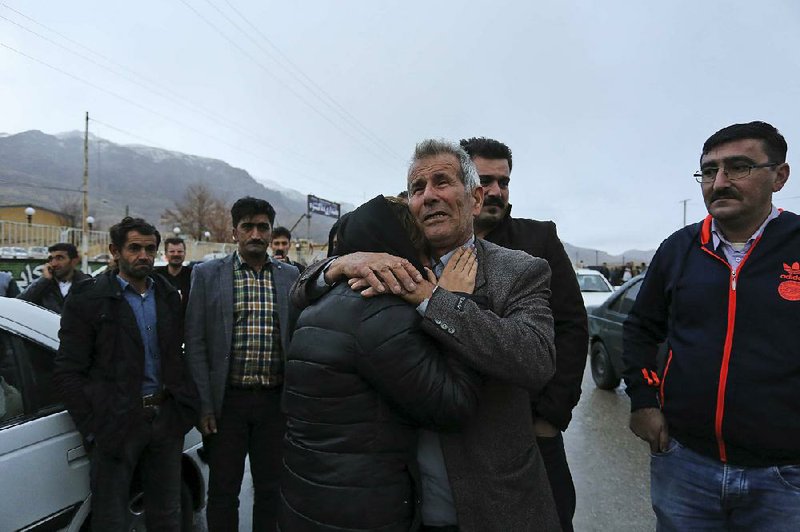TEHRAN, Iran -- An Iranian commercial airplane brought back into service only months ago after being grounded for seven years crashed Sunday in a foggy, mountainous region of southern Iran, and officials feared all 65 people on board were killed.
The crash of the Aseman Airlines ATR-72 marks yet another fatal aviation disaster for Iran, which for years was barred from buying airplane parts for needed maintenance because of Western sanctions over its contested nuclear program.
Its nuclear accord with world powers allows it to get those parts, and the country has made deals worth tens of billions of dollars for new aircraft. However, President Donald Trump's refusal to recertify the deal has injected uncertainty into those sales while Iranians still fly in aging aircraft.
The ATR-72, a twin-engine turboprop used for short-distance regional flying, went down near its destination of the southern Iranian city of Yasuj, some 485 miles south of the Iranian capital, Tehran, where it took off.
It wasn't immediately clear what caused the crash, although weather was severe in the area. Dense fog, high winds and heavy snow in the Zagros Mountains made it impossible for rescue crews in helicopters to reach the site Sunday, state television reported.
Aseman Airlines spokesman Mohammad Taghi Tabatabai told state TV that all on board Flight No. EP3704 were killed. Those on board included 59 passengers and six crew members, the state-run Islamic Republic News Agency reported Sunday night, lowering the number on board to 65 from an initially reported 66. The news agency reported that one passenger did not make the flight.
"After searching the area, we learned that unfortunately ... our dear passengers had lost their lives," Tabatabai said.
The airline later issued a statement saying it could not reach the crash site and could not "accurately and definitely confirm" everyone had died.
Both Supreme Leader Ayatollah Ali Khamenei and President Hassan Rouhani offered their condolences.
Tabatabai said the plane crashed into Mount Dena, which is about 14,435 feet tall. The plane's last signal showed it at 16,975 feet and descending, according to airplane-tracking website FlightRadar24. The pilot was in contact with the tower 14 miles from the airport, state TV said.
One previous passenger on the route posted a video Sunday showing that the flight typically comes in just over the mountain peaks. Aeronautical charts for the airport warn pilots to keep an altitude of 15,000 feet in the area. The airport itself is at nearly 6,000 feet.
The Iranian Red Crescent said it has deployed to the area. Area residents described hearing the crash, although no one had found the crash site yet, according to state TV.
Aseman Airlines, owned by Iran's civil service pension foundation, is a semi-private air carrier headquartered in Tehran that specializes in flights to remote airfields across the country. It also flies internationally.
Aseman Airlines is Iran's third-largest airline by fleet size, behind state carrier Iran Air and Mahan Air. However, it is banned from flying in the European Union over safety concerns.
The carrier has a fleet of 29 aircraft, including six ATR aircraft, according to FlightRadar24. The ATR-72 that crashed Sunday, with the tail number EP-ATS, had been built in 1993, Aseman Airlines CEO Ali Abedzadeh told state TV.
On Instagram, Aseman Airlines highlighted the doomed aircraft in October, saying it had been "grounded" for seven years but would be "repaired and will be operational after checking and testing." It wasn't clear what led to the grounding, though Iran only recently regained access to the airplane parts market after the nuclear deal.
Aseman Airlines has suffered other major crashes with fatalities. In October 1994, a twin-propeller Fokker F-28 1000 commuter plane operated by the airline crashed near Natanz, 180 miles south of Tehran, killing 66 people on board. An Aseman Airlines chartered flight in August 2008, flown by an Itek Air Boeing 737, crashed in Kyrgyzstan, killing 74 people.
Iran has suffered a series of major aviation disasters in recent decades. The last major crash in Iran happened in January 2011, when an Iran Air Boeing 727 broke into pieces on impact while making an emergency landing in a snowstorm in northwestern Iran, killing at least 77 people.
In July 2009, a Russian-made jetliner crashed in northwestern Iran shortly after taking off from Tehran, killing all 168 on board. A Russian-made Ilyushin 76 carrying members of the Revolutionary Guard crashed in the mountains of southeastern Iran in February 2003, killing 302 people.
In February 1993, an Iranian airliner with 132 people aboard collided with an air force jet after takeoff from Tehran's main airport, killing everyone on the two aircraft. And in July 1988, the USS Vincennes in the Strait of Hormuz mistook an Iran Air flight heading to Dubai for an attacking fighter jet, shooting down the plane and killing all 290 people aboard.
Information for this article was contributed by staff members of The New York Times.
A Section on 02/19/2018
